A Review of Enhanced Methods for Oil Recovery from Sediment Void Oil Storage in Underground Salt Caverns
Abstract
1. Introduction
2. The Development of Oil Recovery from Sediment Void
2.1. Oil Recovery Technologies Worldwide
2.2. Oil Recovery Technology in China
2.3. Oil Recovery Influencing Factors Analysis from Sediment Void
2.3.1. Geological Evaluation of Sediment Void Oil Storage
2.3.2. Stability Evaluation of Sediment Void Oil Storage
2.3.3. Tightness Evaluation of Sediment Void Oil Storage
2.3.4. Oil Storage Capacity of Sediment Void Oil Storage
3. Oil Recovery Process and Method from Sediment Void
3.1. Oil Recovery Process of Sediment Void Oil Storage
3.2. Oil Recovery Experiments of Sediment Void Oil Storage
3.3. Oil Recovery Methods of Sediment Void Oil Storage
4. Problems of Oil Recovery from Sediment Void
4.1. Oil Loss Problem of Sediment Void Oil Storage
4.2. Oil Flow Rule in Sediment Void
4.3. Oil Recovery Simulation from Sediment Void
4.4. Sediment Void Oil Storage Construction Problem
5. Advantages and Application of Oil Recovery from Sediment Void
5.1. Potential Advantages of Sediment Void Oil Storage
5.2. Potential Application of Sediment Void Oil Storage
6. Conclusions
- The development of salt cavern oil storage technology was summarized, and the oil recovery technology of salt cavern sediment void oil storage was proposed. The sediment void oil storage method can broke the forbidden zone in cavern construction in high-impurity salt mines. The oil recovery process from salt cavern sediment void was proposed.
- Four influencing factors that influence oil recovery from sediment void were proposed, which are geological evaluation, stability evaluation, tightness evaluation, and oil storage capacity. The geological evaluation results can influence the connectivity of sediment void and oil recovery ratio.
- The oil recovery process of sediment void oil storage was proposed, and the corresponding oil recovery experiment was summarized. A series of techniques enhancing oil recovery methods for the sediment void oil extraction process were proposed. The overall oil recovery process of sediment void oil storage was proposed.
- The four problems that influence the oil recovery of sediment void oil storage were proposed, which are oil loss in sediment void, oil flow rule in sediment void, oil recovery simulation in sediment void, and sediment void oil storage construction.
- The potential advantages of sediment void oil storage construction in China were analyzed, and the potential application oil recovery in sediment void was analyzed. China has rich rock salt and other convenient conditions to develop SVOS.
Author Contributions
Funding
Data Availability Statement
Conflicts of Interest
References
- Haouel, C. Assessment of the Impact of Russia’s War on Ukraine on EU and UK Oil and Gas Imports and Their Energy Supply Security. In Proceedings of the Central and Eastern European eDem and eGov Days, Budapest, Hungary, 14–15 September 2023; pp. 166–177. [Google Scholar]
- Sharples, J.D. Russia-Ukraine Gas Conflicts. In Encyclopedia of Mineral and Energy Policy; Springer: Berlin/Heidelberg, Germany, 2023; pp. 629–634. [Google Scholar]
- Bada, O.T.; Adetiloye, K.A.; Olokoyo, F.O.; Ukporhe, G. Determinants of International Reserves Among Organisation of Petroleum Exporting Countries (OPEC). Comp. Econ. Res. Cent. East. Eur. 2022, 25, 111–133. [Google Scholar] [CrossRef]
- Mara, D.; Nate, S.; Stavytskyy, A.; Kharlamova, G. The Place of Energy Security in the National Security Framework: An Assessment Approach. Energies 2022, 15, 658. [Google Scholar] [CrossRef]
- Alola, A.A.; Özkan, O.; Obekpa, H.O. Examining the Patterns of Disaggregate Energy Security Risk and Crude Oil Price: The USA Scenario Over 1970–2040. Resour. Policy 2023, 82, 103514. [Google Scholar] [CrossRef]
- Blanco-Martín, L.; Rouabhi, A.; Hadj-Hassen, F. Use of Salt Caverns in the Energy Transition: Application to Power-to-Gas–Oxyfuel. J. Energy Storage 2021, 44, 103333. [Google Scholar] [CrossRef]
- Hou, B.; Shangguan, S.; Niu, Y.; Su, Y.; Yu, C.; Liu, X.; Li, Z.; Li, J.; Liu, X.; Zhao, K. Unique Properties of Rock Salt and Application of Salt Caverns on Underground Energy Storage: A Mini Review. Energy Sources Part A Recovery Util. Environ. Eff. 2024, 46, 621–635. [Google Scholar] [CrossRef]
- Yang, Y.; Liu, Z.; Saydaliev, H.B.; Iqbal, S. Economic Impact of Crude Oil Supply Disruption on Social Welfare Losses and Strategic Petroleum Reserves. Resour. Policy 2022, 77, 102689. [Google Scholar] [CrossRef]
- Mortazavi, A.; Nasab, H. Analysis of the Behavior of Large Underground Oil Storage Caverns in Salt Rock. Int. J. Numer. Anal. Methods Geomech. 2016, 41, 602–624. [Google Scholar] [CrossRef]
- Abreu, J.F.; Costa, A.M.; Costa, P.V.; Miranda, A.C.; Zheng, Z.; Wang, P.; Ebecken, N.F.F.; de Carvalho, R.S.; dos Santos, P.L.P.; Lins, N.; et al. Carbon Net Zero Transition: A Case Study of Hydrogen Storage in Offshore Salt Cavern. J. Energy Storage 2023, 62, 106818. [Google Scholar] [CrossRef]
- Matos, C.R.; Carneiro, J.F.; Silva, P.P. Overview of Large-Scale Underground Energy Storage Technologies for Integration of Renewable Energies and Criteria for Reservoir Identification. J. Energy Storage 2019, 21, 241–258. [Google Scholar] [CrossRef]
- Guo, X.; Hao, C.; Niu, S. Analysis of Oil Import Risk and Strategic Petroleum Reserve: The Case of China. Sustainability 2020, 12, 3723. [Google Scholar] [CrossRef]
- Shang, J.; Hamori, S. The Response of Oil-Importing and Oil-Exporting Countries’ Macroeconomic Aggregates to Crude Oil Price Shocks: Some International Evidence. Eurasian Econ. Rev. 2024, 14, 933–980. [Google Scholar] [CrossRef]
- Pan, L.; Liu, P.; Li, Z. A System Dynamic Analysis of China’s Oil Supply Chain: Over-Capacity and Energy Security Issues. Appl. Energy 2017, 188, 508–520. [Google Scholar] [CrossRef]
- Xie, Y.; Wu, X.; Hou, Z.; Li, Z.; Luo, J.; Lüddeke, C.T.; Huang, L.; Wu, L.; Liao, J. Gleaning Insights from German Energy Transition and Large-Scale Underground Energy Storage for China’s Carbon Neutrality. Int. J. Min. Sci. Technol. 2023, 33, 529–553. [Google Scholar] [CrossRef]
- Wang, Q.; Li, S.; Li, R. China’s Dependency on Foreign Oil Will Exceed 80% by 2030: Developing a Novel NMGM-ARIMA to Forecast China’s Foreign Oil Dependence from Two Dimensions. Energy 2018, 163, 151–167. [Google Scholar] [CrossRef]
- Wei, X.; Shi, X.; Li, Y.; Ban, S.; Liu, X.; Xue, T.; Ma, H.; Liu, H.; Yang, C. Optimization of Engineering for the Salt Cavern Oil Storage (SCOS) During Construction in China. Geoenergy Sci. Eng. 2024, 233, 212567. [Google Scholar] [CrossRef]
- Ikevuje, A.H.; Kwakye, J.M.; Ekechukwu, D.E.; Ogundipe, O.B.; Esiri, A.E. Negative Crude Oil Prices: Supply Chain Disruptions and Strategic Lessons. Open Access Res. J. Multidiscip. Stud. 2024, 8, 085–093. [Google Scholar] [CrossRef]
- Hart, D.; Zeitler, T.; Sobolik, S. 2022 Annual Report of Available Drawdowns for Each Oil Storage Cavern in the Strategic Petroleum Reserve; Sandia National Laboratory: Albuquerque, NM, USA, 2024. [Google Scholar] [CrossRef]
- Paca, E. Assessing the Technical Feasibility of Converting US Salt Caverns Used for Natural Gas Storage into Hydrogen Storage Facilities. PhD Thesis, Massachusetts Institute of Technology, Cambridge, MA, USA, 2023. [Google Scholar]
- Armstrong, L.G.; Hager, B.H.; Coyle, S.; Bergmann, K.D.; Fukumoto, C.; Mallapragada, D.S. A Novel Methodology to Map Hydrogen Storage Potential in Salt Caverns: A Case Study of the Midwestern and Appalachian Regions of the United States. arXiv 2024. [Google Scholar] [CrossRef]
- Michalski, J.; Bünger, U.; Crotogino, F.; Donadei, S.; Schneider, G.-S.; Pregger, T.; Cao, K.-K.; Heide, D. Hydrogen generation by electrolysis and storage in salt caverns: Potentials, economics and systems aspects with regard to the German energy transition. Int. J. Hydrogen Energy 2017, 42, 13427–13443. [Google Scholar] [CrossRef]
- Caglayan, D.G.; Weber, N.; Heinrichs, H.U.; Linßen, J.; Robinius, M.; Kukla, P.A.; Stolten, D. Technical Potential of Salt Caverns for Hydrogen Storage in Europe. Int. J. Hydrogen Energy 2020, 45, 6793–6805. [Google Scholar] [CrossRef]
- Tarkowski, R.; Lankof, L.; Luboń, K.; Michalski, J. Hydrogen Storage Capacity of Salt Caverns and Deep Aquifers Versus Demand for Hydrogen Storage: A Case Study of Poland. Appl. Energy 2024, 355, 122268. [Google Scholar] [CrossRef]
- Wang, T.; Liao, Y.; He, T.; Xie, D.; Ren, Z.; Qin, K.; Zhang, C. Oil Recovery and Cooling for Underground Salt Cavern Oil Storage: Insights from Coupled Flow and Thermal Model. Geoenergy Sci. Eng. 2025, 244, 213456. [Google Scholar] [CrossRef]
- Zhang, S.; Liang, W.; Xu, S.; Xiao, N.; Li, J. Experimental Study on Creep Properties of Deep Impurity Salt Rocks. Rock Mech. Rock Eng. 2024, 58, 787–806. [Google Scholar] [CrossRef]
- Wei, X.; Shi, X.; Li, Y.; Liu, H.; Li, P.; Ban, S.; Liang, X.; Zhu, S.; Zhao, K.; Yang, K.; et al. Advances in Research on Gas Storage in Sediment Void of Salt Cavern in China. Energy 2023, 284, 129243. [Google Scholar] [CrossRef]
- Wei, X.; Shi, X.; Li, Y.; Ma, H.; Ban, S.; Liu, X.; Liu, H.; Yang, C. Analysis of the European Energy Crisis and Its Implications for the Development of Strategic Energy Storage in China. J. Energy Storage 2024, 82, 110522. [Google Scholar] [CrossRef]
- Sobolik, S.R.; Ehgartner, B.L. Analyzing Large Pressure Changes on the Stability of Large-Diameter Caverns Using the MD Model. In Mechanical Behaviour of Salt VII, 1st ed.; Taylor and Francis Group: London, UK, 2012; pp. 321–329. [Google Scholar]
- Park, B.Y.; Ehgartner, B.L.; Herrick, C.G. Allowable Pillar to Diameter Ratio for Strategic Petroleum Reserve Caverns. In Proceedings of the 45th U.S. Rock Mechanics/Geomechanics Symposium, San Francisco, CA, USA, 26–29 June 2011. ARMA-11-219. [Google Scholar]
- Park, B.Y.; Roberts, B.L.; Sobolik, S.R. Construction of hexahedral finite element mesh capturing realistic geometries of a petroleum reserve. Finite Elem. Anal. Des. 2017, 135, 68–78. [Google Scholar] [CrossRef]
- Ehgartner, B.L.; Sobolik, S.R. Analysis of Cavern Shapes for the Strategic Petroleum Reserve; Sandia National Laboratories (SNL): Albuquerque, NM, USA; Livermore, CA, USA, 2006. [Google Scholar]
- Park, B.Y. Interbed modeling to predict wellbore damage for Big Hill strategic petroleum reserve. Rock Mech. Rock Eng. 2014, 47, 1551–1561. [Google Scholar] [CrossRef][Green Version]
- Park, B.Y. Geomechanical Analysis to Predict the Oil Leak at the Wellbores in Big Hill Strategic Petroleum Reserve; Sandia National Lab. (SNL-NM): Albuquerque, NM, USA, 2014. [Google Scholar]
- Park, B.Y.; Sobolik, S.R.; Herrick, C.G. Geomechanical model calibration using field measurements for a petroleum reserve. Rock Mech. Rock Eng. 2018, 51, 925–943. [Google Scholar] [CrossRef]
- Castaneda, J.N.; Shollenberger, K.A.; Torczynski, J.R.; Cote, R.O.; Barney, J.; O’Hern, T.J. Investigation of Oil Injection into Brine for the Strategic Petroleum Reserve: Hydrodynamics Experiments with Simulant Liquids; Sandia National Laboratories (SNL): Albuquerque, NM, USA; Livermore, CA, USA, 2003. [Google Scholar]
- Bazaluk, O.; Slabyi, O.; Vekeryk, V.; Velychkovych, A.; Ropyak, L.; Lozynskyi, V. A technology of hydrocarbon fluid production intensification by productive stratum drainage zone reaming. Energies 2021, 14, 3514. [Google Scholar] [CrossRef]
- Panevnik, D.; Velichkovich, A. Assessment of the stressed state of the casing of the above-bit hydroelevator. Oil Ind. J. 2017, 2017, 70–73. [Google Scholar]
- Dutkiewicz, M.; Shatskyi, I.; Martsynkiv, O.; Kuzmenko, E. Mechanism of casing string curvature due to displacement of surface strata. Energies 2022, 15, 5031. [Google Scholar] [CrossRef]
- Wang, T.; Yang, C.; An, G.; Zhang, Q.; Wang, W.; Han, J. Salt Cavern Oil Storage Stability Evaluation Method. China. CN110096824A, 6 August 2019. Available online: https://cprs.patentstar.com.cn/Search/Detail?ANE=6AEA8FDA9IHHCFFA7FBA9IGF9GFF9CAB9IHH9CGC9HDD9DCA (accessed on 29 December 2024).
- Wei, X.X.; Shi, X.L.; Ma, H.L.; Ban, S.N.; Bai, W.Z. Experimental investigation on the oil extraction process for a novel underground oil storage method: Oil storage in salt cavern insoluble sediment voids. Energy 2024, 309, 133061. [Google Scholar] [CrossRef]
- Liu, R.; Jiang, Y.; Li, B.; Wang, X. A fractal model for characterizing fluid flow in fractured rock masses based on randomly distributed rock fracture networks. Comput. Geotech. 2015, 65, 45–55. [Google Scholar] [CrossRef]
- Crotogino, F.; Schneider, G.-S.; Evans, D.J. Renewable energy storage in geological formations. Proc. Inst. Mech. Eng. Part A J. Power Energy 2018, 232, 100–114. [Google Scholar] [CrossRef]
- Ma, X.; Zheng, D.; Zhang, G.; Li, D. General Situation of Underground Gas Storage Around the World. In Handbook of Underground Gas Storages and Technology in China; Ma, X., Ed.; Springer: Singapore, 2020; pp. 1–31. [Google Scholar]
- Zhao, H.; Hao, X. Risk assessment of zero-carbon salt cavern compressed air energy storage power station. J. Clean. Prod. 2024, 468, 143002. [Google Scholar] [CrossRef]
- Stepanek, J.; Minkley, W.; Syblik, J.; Dostal, V. Thermodynamic analysis of compressed CO2 energy storage in salt caverns with gravel stabilization. J. Energy Storage 2024, 82, 110509. [Google Scholar] [CrossRef]
- Cyran, K.; Kowalski, M. Effect of pillar width on the stability of the salt cavern field for energy storage. Stud. Geotech. Mech. 2024, 46, 147–163. [Google Scholar] [CrossRef]
- Douet, J. The Heritage of the Oil Industry; TICCIH–The International Committee for the Conservation of the Industrial Heritage: Houghton, MI, USA, 2019. [Google Scholar]
- Sobolik, S.R. Analyzing the effect of large pressure changes on the operational stability of large-diameter caverns for the strategic petroleum reserve. Conference: Analyzing the Effect of Large Pressure Changes on the Operational Stability of Large-Diameter Caverns for the Strategic Petroleum Reserve. In Proceedings of the 47th U.S. Rock Mechanics/Geomechanics Symposium, San Francisco, CA, USA, 23–26 June 2013. ARMA-2013-226. [Google Scholar]
- Bérest, P.; Réveillère, A.; Evans, D.; Stöwer, M. Review and analysis of historical leakages from storage salt caverns wells. Oil Gas Sci. Technol.–Rev. D’ifp Energ. Nouv. 2019, 74, 27. [Google Scholar] [CrossRef]
- Schaber, C.; Mazza, P.; Hammerschlag, R. Utility-scale storage of renewable energy. Electr. J. 2004, 17, 21–29. [Google Scholar] [CrossRef]
- Brockmann, B.; Donadei, S.; Crotogino, F. Energy Storage in Salt Caverns—Renewable Energies in the Spotlight: Underground Storage of CO2 and Energy; CRC Press: Boca Raton, FL, USA, 2010. [Google Scholar]
- Wei, X.; Shi, X.; Li, Y.; Li, P.; Ban, S.; Zhao, K.; Ma, H.; Liu, H.; Yang, C. A comprehensive feasibility evaluation of salt cavern oil energy storage system in China. Appl. Energy 2023, 351, 121807. [Google Scholar] [CrossRef]
- Wei, X.; Ban, S.; Shi, X.; Li, P.; Li, Y.; Zhu, S.; Yang, K.; Bai, W.; Yang, C. Carbon and energy storage in salt caverns under the background of carbon neutralization in China. Energy 2023, 272, 127120. [Google Scholar] [CrossRef]
- Tadros, A.F.F. Environmental aspects of petroleum storage in above-ground tank. In Proceedings of the International Conference on Sustainable Futures: Environmental, Technological, Social and Economic Matters (ICSF 2020), Kryvyi Rih, Ukraine, 20–22 May 2020; p. 01006. [Google Scholar]
- Krishnan, B.; Ali, A.; Al Harbi, M.; Natarajan, E. Advancing aboveground storage tank integrity: Exploring and implementing online robotic inspection. In Proceedings of the SPE Caspian Technical Conference and Exhibition, Atyrau, Kazakhstan, 26–28 November 2024; p. D011S05R05, SPE-223425-MS. [Google Scholar]
- Li, K.; Zhou, B.; Xie, X.; Ma, X.; Jin, G. Anti-Floatation Design Test and Simulation Study of Large LNG Underground Storage Tanks. Proceedings of the IOP Conference Series: Earth and Environmental Science; IOP Publishing: Bristol, UK; p. 062022.
- Naithani, A. Underground rock caverns for strategic crude oil storage in India—Nature of studies, design and construction. Curr. Sci. 2012, 103, 490–496. [Google Scholar]
- Lux, K.-H. Design of salt caverns for the storage of natural gas, crude oil and compressed air: Geomechanical aspects of construction, operation and abandonment. Geol. Soc. Lond. Spec. Publ. 2009, 313, 93–128. [Google Scholar] [CrossRef]
- Vandiver, J.K.; Mitome, S. The effect of liquid storage tanks on the dynamic response of offshore platforms. J. Pet. Technol. 1979, 31, 1231–1240. [Google Scholar] [CrossRef]
- Liu, D.; Wang, X.; Chen, Y. An experimental study of three-dimensional separation surface sloshing in the wet storage tank of a floating offshore platform. J. Mar. Sci. Eng. 2024, 12, 558. [Google Scholar] [CrossRef]
- Sun, X.; Ding, G.; Li, K.; Xin, C.; Wu, Z.; Gou, Y.; Ran, L.; Li, H.; Bai, S.; Wu, J. Research on the influencing factors of the void volume of insoluble sediment in salt cavern gas storage. Processes 2024, 12, 636. [Google Scholar] [CrossRef]
- Liang, X.; Ma, H.; Cai, R.; Zhao, K.; Zeng, Z.; Li, H.; Yang, C. Feasibility analysis of natural gas storage in the voids of sediment within salt cavern—Case study in China. Energy 2023, 285, 129340. [Google Scholar] [CrossRef]
- Giles, H.N.; Koenig, J.J.; Neihof, R.A.; Shay, J.Y.; Woodward, P.W. Stability of refined products and crude oil stored in large cavities in salt deposits: Biogeochemical aspects. Energy Fuels 1991, 5, 602–608. [Google Scholar] [CrossRef]
- Zhang, N. Study on the mechanical properties, permeability, and safety evaluation of surrounding rocks in layered salt rock oil storage. Ph.D. Thesis, Chongqing University, Chongqing, China, 2019. (In Chinese). [Google Scholar]
- Liang, X.; Ma, H.; Cai, R.; Zhao, K.; Wang, X.; Zheng, Z.; Shi, X.; Yang, C. Study of impact of sediment on the stability of salt cavern underground gas storage. Energies 2023, 16, 7825. [Google Scholar] [CrossRef]
- Wang, X.; Wang, J.; Zhao, P.; Liu, X.; Feng, S.; Song, Z. Study on the long-term airtightness of salt cavern gas storage considering the permeability variation of surrounding rock. Comput. Geotech. 2024, 168, 106130. [Google Scholar] [CrossRef]
- Réveillère, A. The development of the concern for tightness in the salt cavern industries, of accurate tightness test techniques, and of the concept of mechanical integrity test. Ph.D. Thesis, Sorbonne Université, Paris, France, 2021. [Google Scholar]
- Sun, X.L. Research and application of airtightness detection in salt cavern gas storage. China Salt Ind. J. 2018, 49, 20–22. [Google Scholar]
- Yang, H.; Wang, Y.; Dai, Y.; Zhang, J.; Chen, G. On the acoustic attenuation characteristics of sonar detection in the salt-cavern gas storage environment. Front. Earth Sci. 2023, 10, 1029946. [Google Scholar] [CrossRef]
- Ehgartner, B.L.; Park, B.Y.; Lee, M.Y. Three-Dimensional Simulation for Bayou Choctaw Strategic Petroleum Reserve (SPR); AND2006-7589; Sandia National Laboratories (SNL): Albuquerque, NM, USA; Livermore, CA, USA, 2006; p. 84. [Google Scholar]
- Liu, L.; Shi, Z.; Peng, M.; Liu, C.; Tao, F.; Liu, C. Numerical modeling for karst cavity sonar detection beneath bored cast in situ pile using 3D staggered grid finite difference method. Tunn. Undergr. Space Technol. 2018, 82, 50–65. [Google Scholar] [CrossRef]
- Wei, X.; Shi, X.; Li, Y.; Li, P.; Ban, S.; Xue, T.; Zhu, S.; Liu, H.; Yang, C. Field experimental and theoretical research on creep shrinkage mechanism of ultra-deep energy storage salt cavern. Rock Mech. Rock Eng. 2023, 57, 287–305. [Google Scholar] [CrossRef]
- Sobolik, S.R.; Lord, A. Operation, maintenance, and monitoring of large-diameter caverns in oil storage facilities in domal salt. In Mechanical Behaviour of Salt VIII; Taylor Francis Group: Abingdon, UK, 2015. [Google Scholar]
- Zhao, K. Ancient Salt Roads of China; Springer Nature: Berlin, Germany, 2024. [Google Scholar]
- Jianan, W.; Dewen, Z.; Guosheng, D.; Qiqi, W.; Kang, L.; Lina, R.; Yanxia, K.; Song, B.; Haitao, L. Stability evaluation of the constructed salt cavities of Jintan gas storage in China. In Proceedings of the 57th U.S. Rock Mechanics/Geomechanics Symposium, Atlanta, GA, USA, 25–28 June 2023. ARMA-2023-0907. [Google Scholar]
- Zhang, Y.; Gao, Y.; Zhang, Y.; Liang, Z.; Zhang, Z.; Zhao, Y.; Li, P. Assessment of agricultural water resources carrying capacity and analysis of its spatio-temporal variation in Henan Province, China. J. Clean. Prod. 2023, 403, 136869. [Google Scholar] [CrossRef]
- Turner, R.E.; Rabalais, N.N. The Gulf of Mexico. In World Seas: An Environmental Evaluation; Elsevier: Amsterdam, The Netherlands, 2019; pp. 445–464. [Google Scholar]
- Wei, X.X.; Shi, X.L.; Ma, H.L.; Bai, W.Z.; Ban, S.N.; Liu, H.J. Oil storage and debrining process in insoluble sediment voids for underground salt cavern energy storage: An experimental study. Geoenergy Sci. Eng. 2024, 243, 213359. [Google Scholar] [CrossRef]
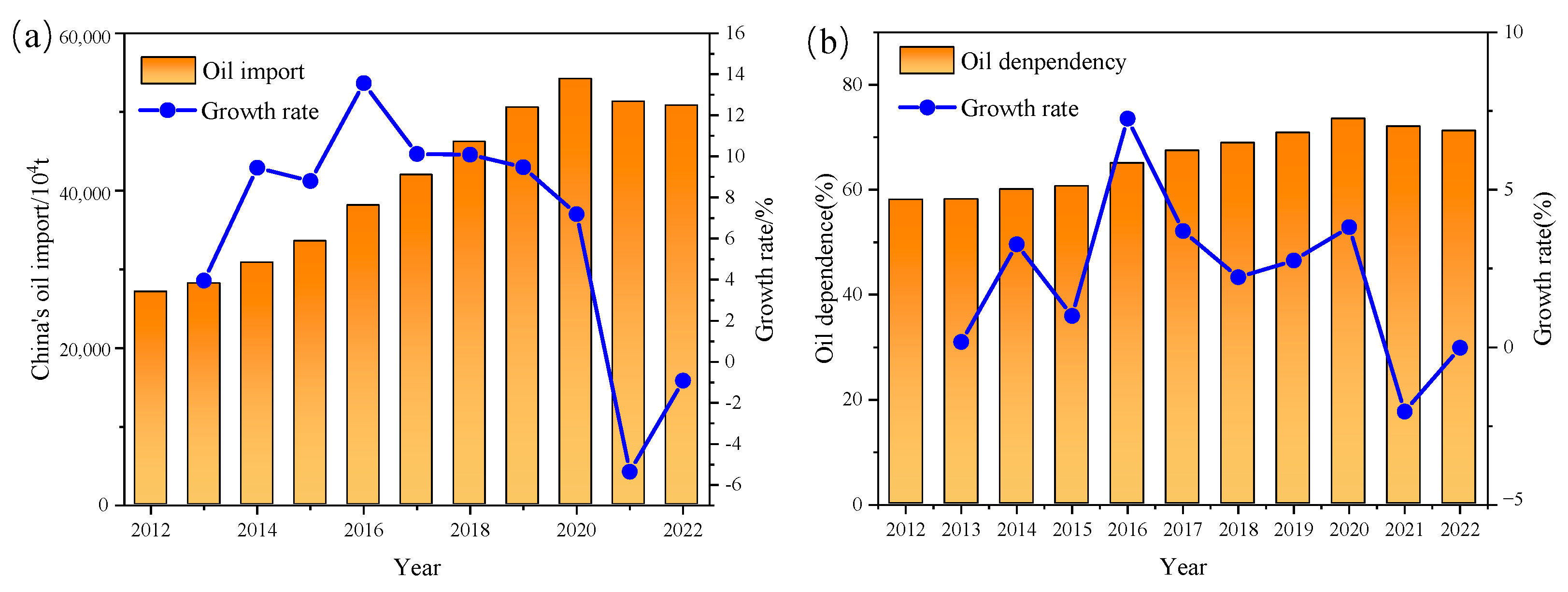



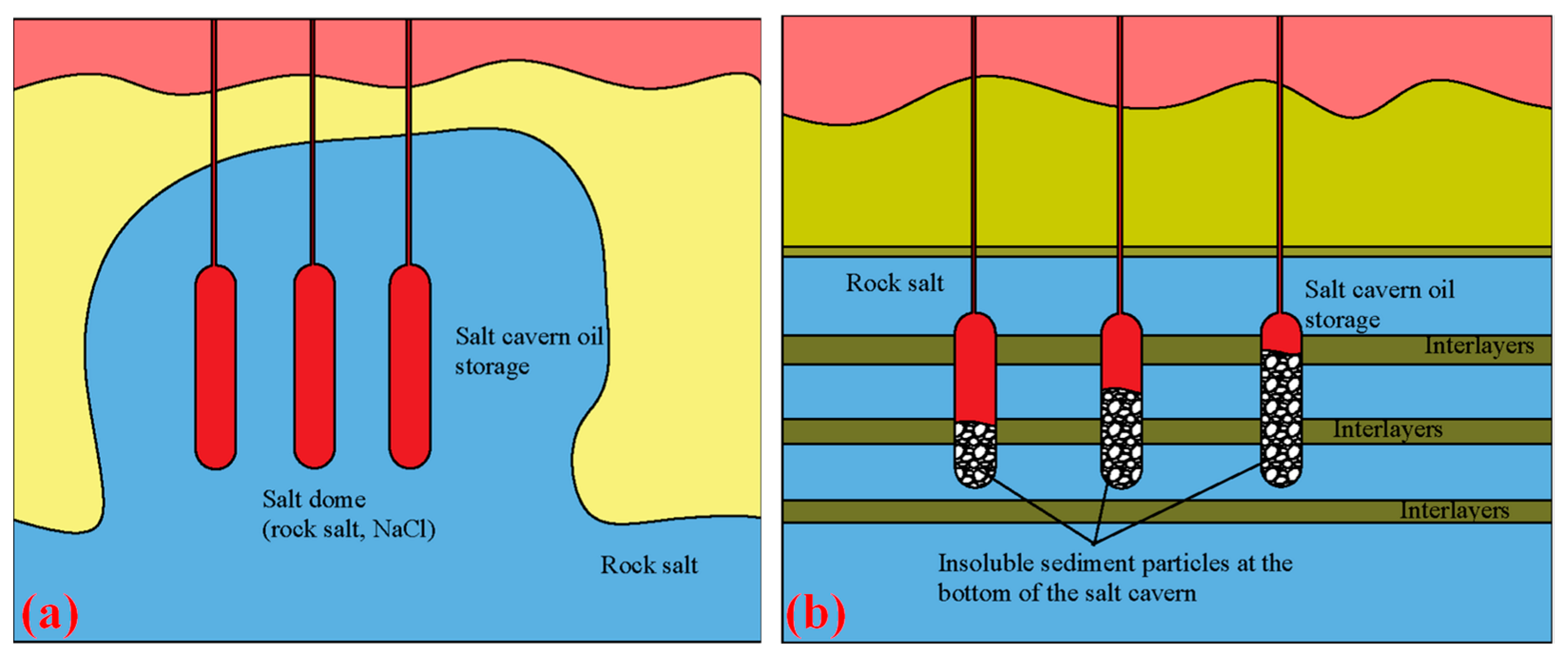
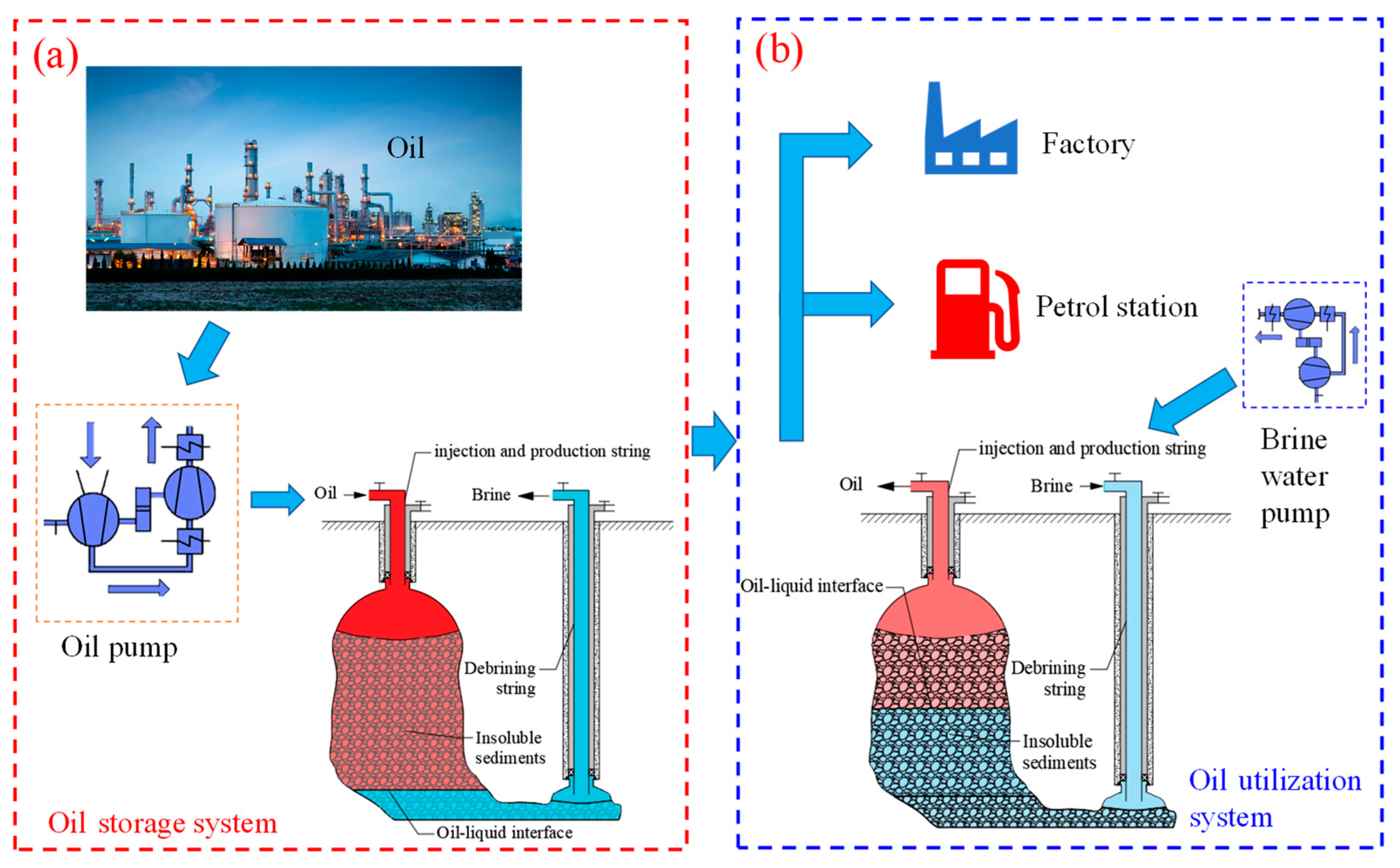
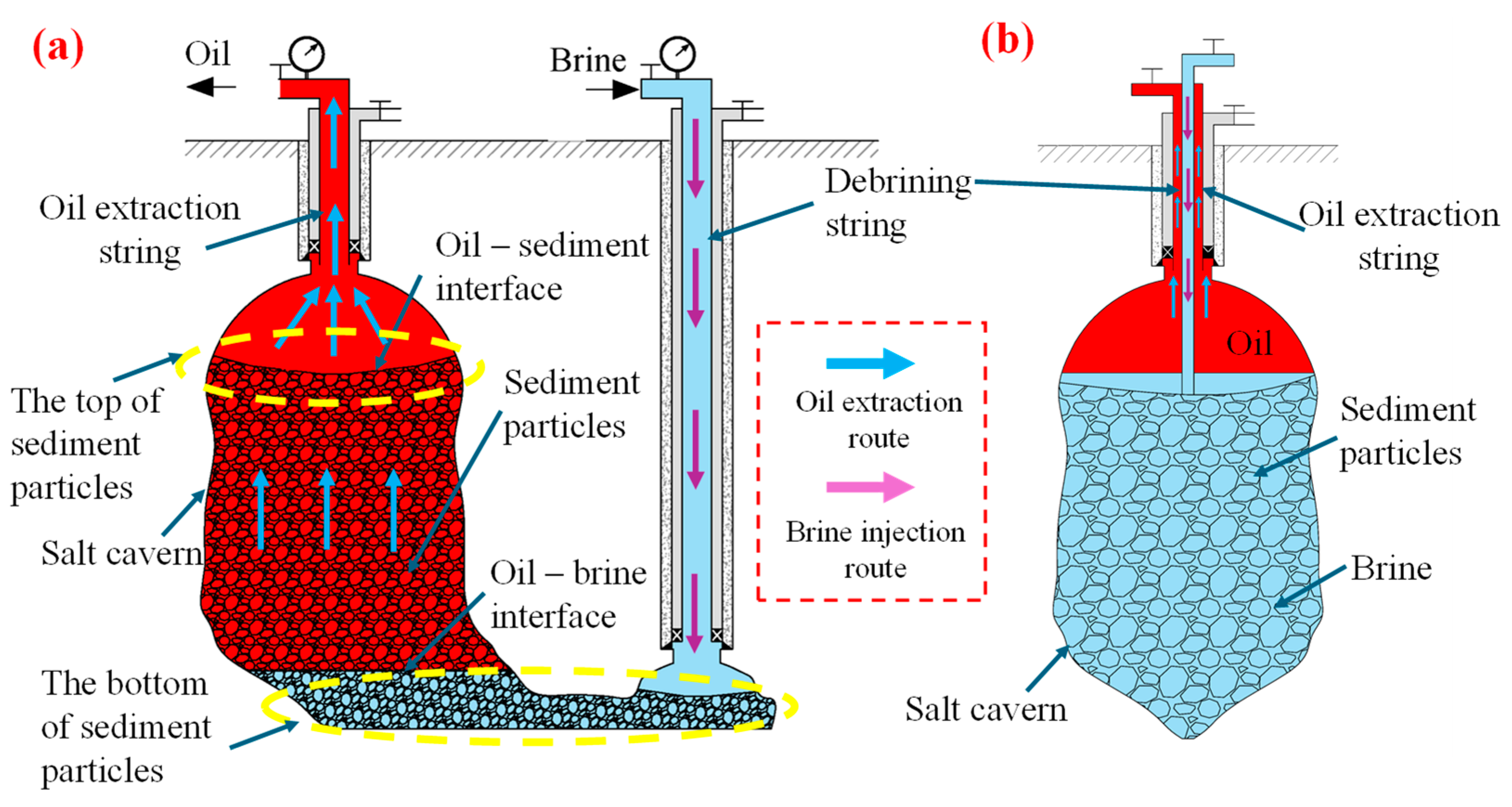


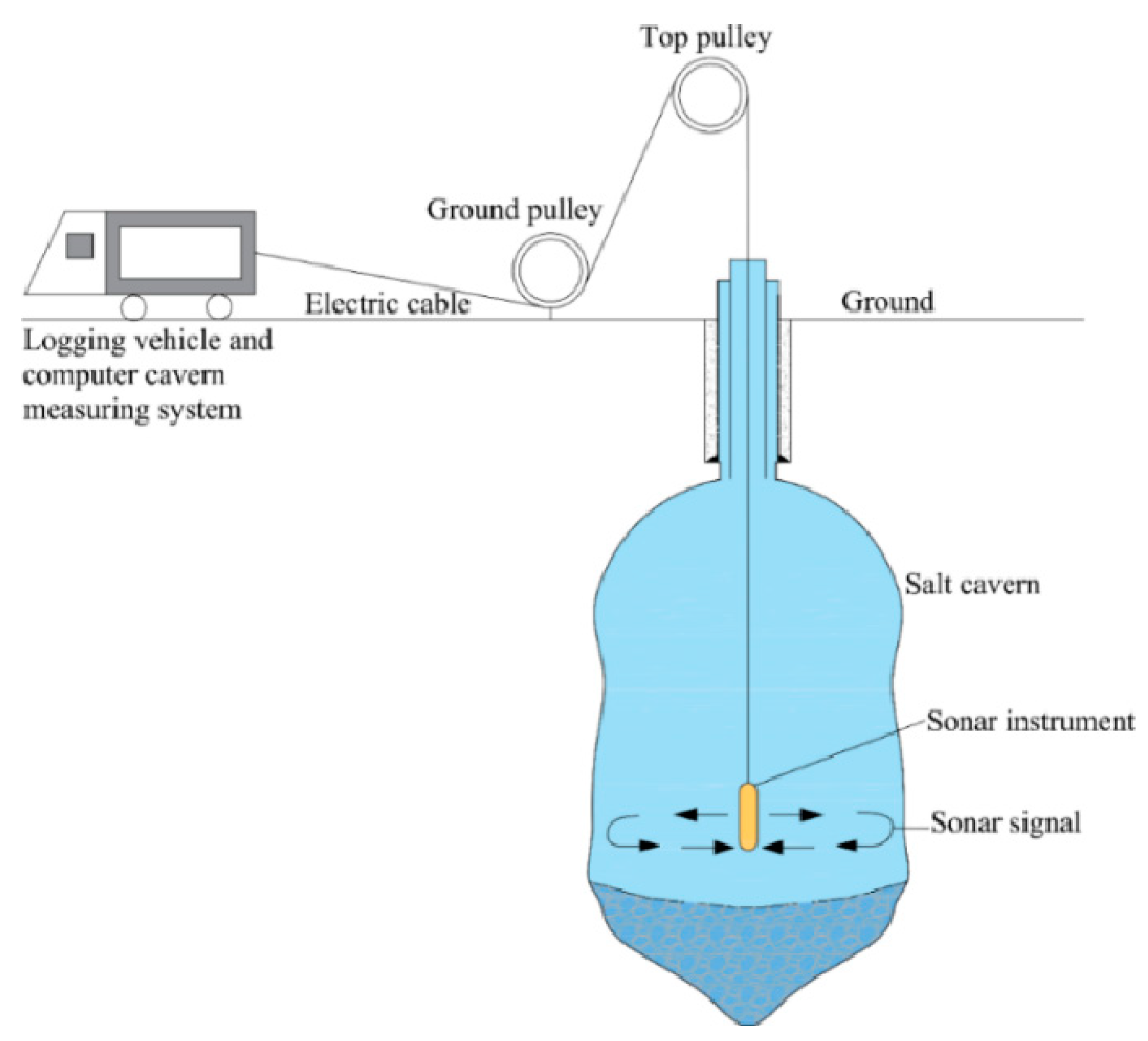
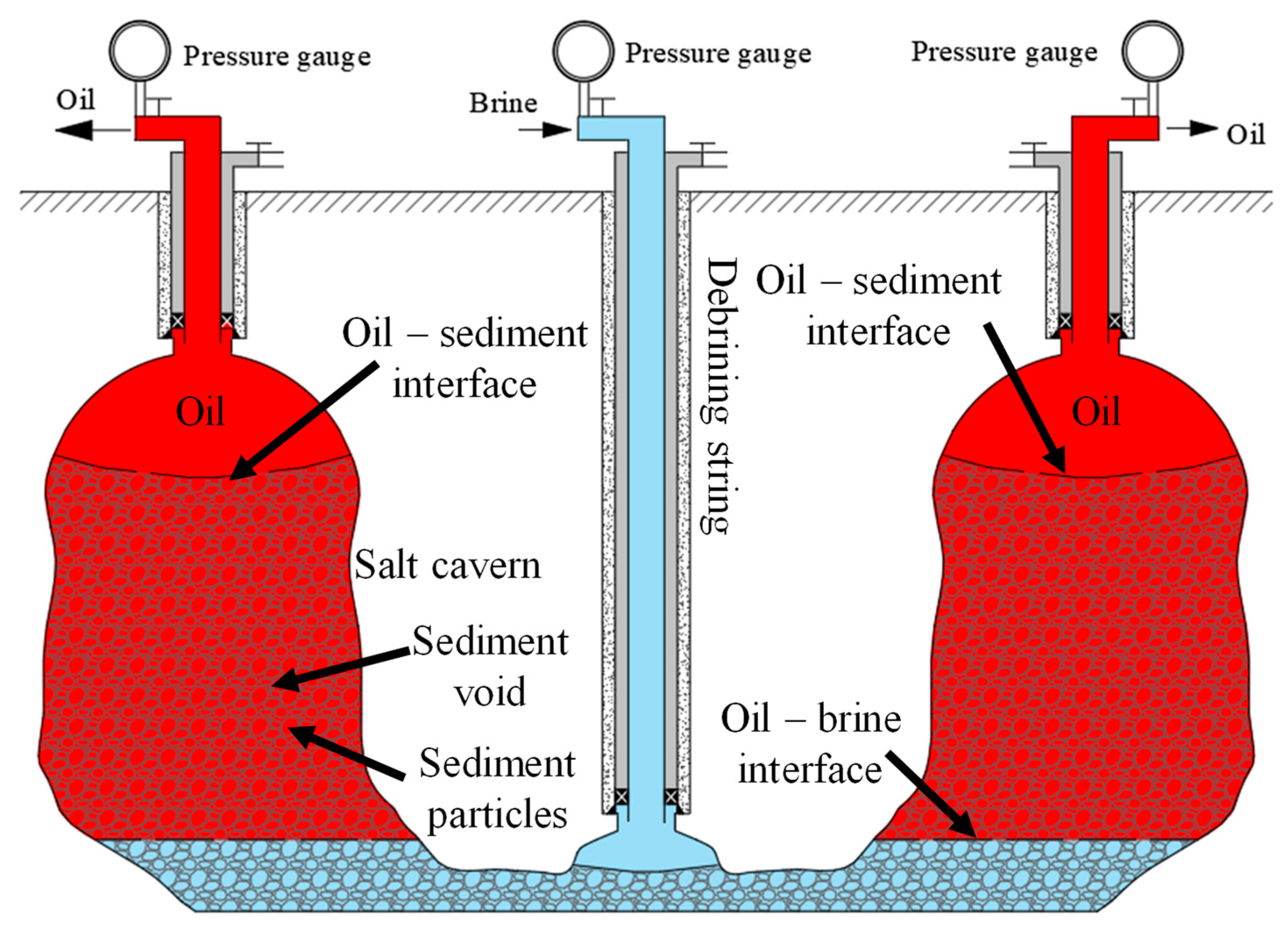


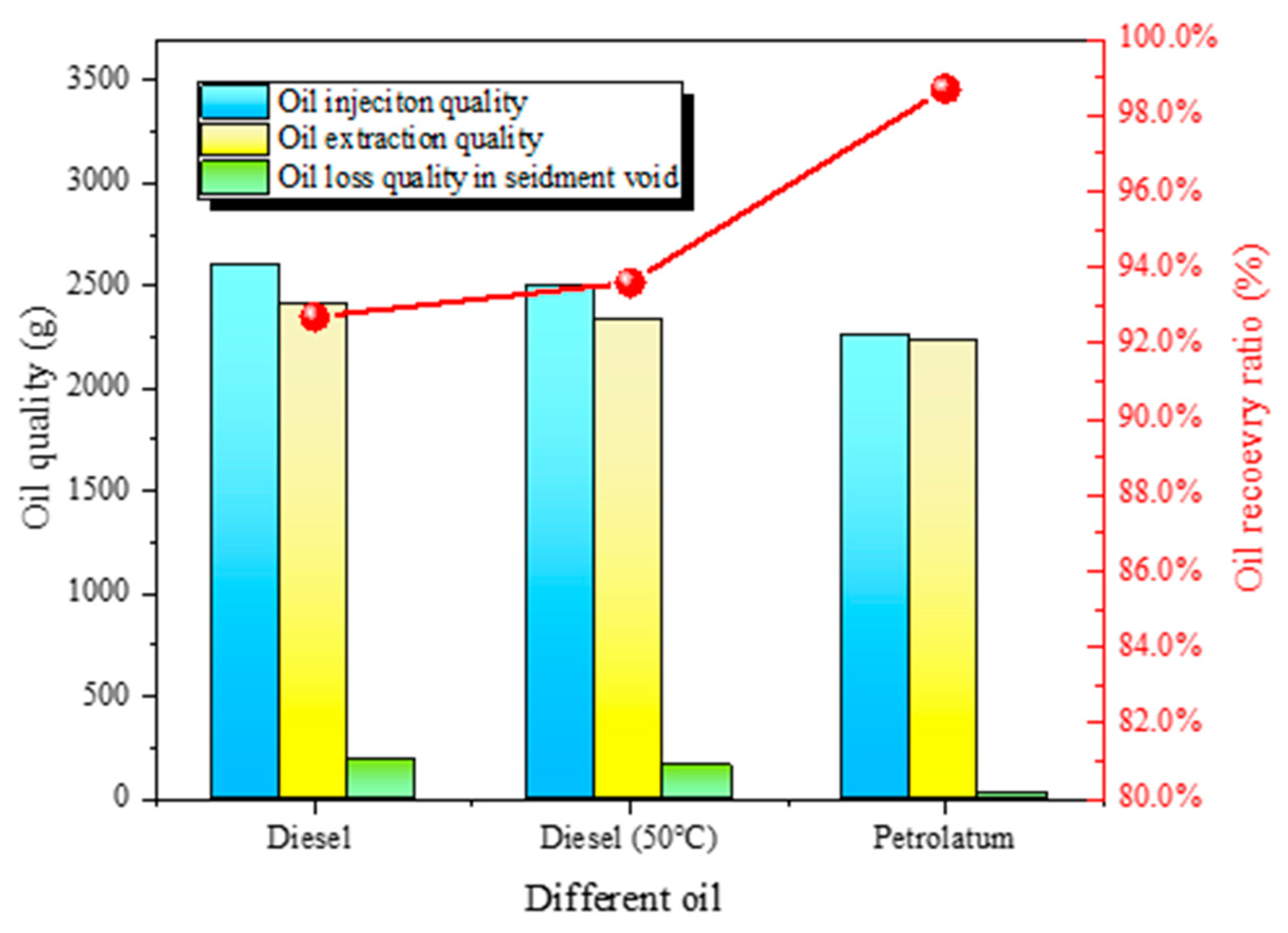
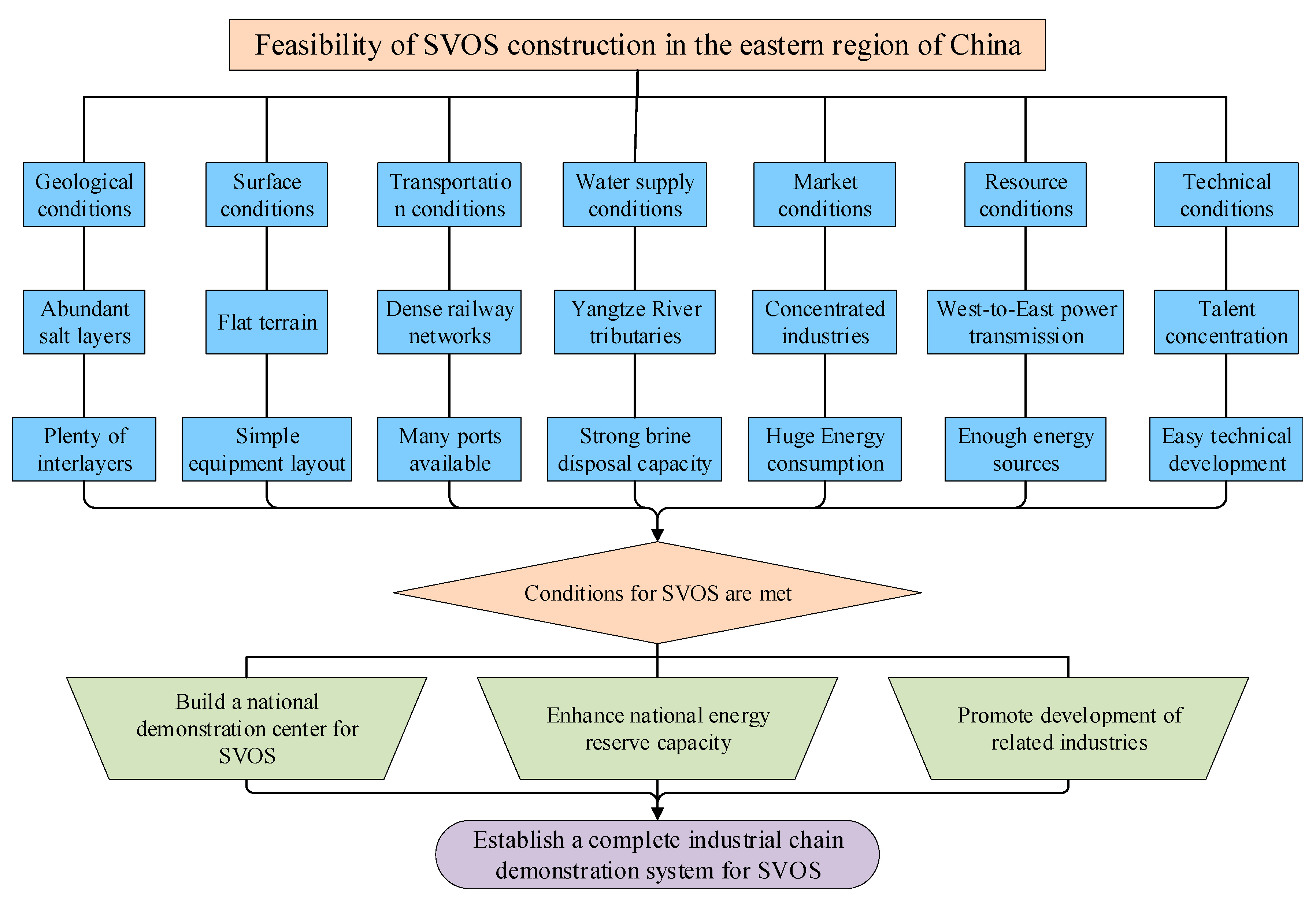

| Oil Storage Method | Total Cost for 100 Million Barrels/108 Dollar | Cost per Barrel/Dollar | Annual Production Cost/106 Dollar |
|---|---|---|---|
| Underground salt cavern | 5.5 | 5.5 | 17.5 |
| Underground rock cavern | 15.4 | 15.4 | 8.8 |
| Surface storage tank | 35.0 | 35.0 | —— |
| Oil Storage Method | Construction Characteristics | Advantages | Disadvantages | Application |
|---|---|---|---|---|
| Aboveground oil tank storage [55,56] | Easy to build | Simple structure | Large area, oil leakage caused by tank rupture, high risk, low security | Inland refinery |
| Semi-underground oil tank storage [57] | The buried depth of the oil tank is greater than 50% of the tank height | Good fire safety performance | Covers a large area, easily leaking | Inland refinery |
| Underground rock cavern oil storage [58] | Excavate caves manually and seal oil through the pressure difference between groundwater and oil products | Good sealing property, not easy to destroy, not easily leaking, low risk | Difficult site selection | Good location of underground caverns |
| Underground salt cavern oil storage [59] | Using salt cavern formed by solution mining to store oil | Strong bearing capacity, impermeability | Difficult site selection; insoluble sediment particles take up oil storage space | An area with good salt rock strata |
| Offshore oil storage tank [60,61] | Floating tanks and bottom tanks | Not occupying land area; it can be rebuilt by abandoned tankers | Oil spills pollute the marine environment; poor security | Oil refinery along the river |
| Test Name | Currently Applied Area | Medium | Test Method |
|---|---|---|---|
| Gas leakage test method | North America | Nitrogen or air | Nitrogen or air is injected into the cavity, and the gas–water interface is monitored using logging instruments to evaluate the sealing performance of the cavern. |
| Liquid leakage test method | European region | Fuel oil | The integrity of the cavern’s seal can be evaluated by injecting fuel oil, monitoring the wellhead pressure, and recovering the fuel oil to compare the volume within the cavern. |
| Oil Storage and Recovery Technology of Salt Cavern | Oil Recovery Principle | Oil Recovery Process Flow | Related Ground Facilities | Applicability |
|---|---|---|---|---|
| Situated brine to displace oil | The saturated brine is injected into the salt cavern, displacing the oil towards the surface due to the difference in specific gravity between the brine and the oil. | Saturated brine storage tank → Brine injection system → Salt cavern sediment void → Oil extraction from sediment void → Oil storage tank | Brine storage tank, high-pressure injection and production pumps, water injection, oil injection pipelines, crude oil system, and supporting equipment. | The process is well established, but the demand for saturated brine is high. |
| Freshwater to displace oil | Freshwater is injected into the salt cavern, displacing the crude oil towards the surface due to the difference in specific gravity between the oil and the water. | Freshwater storage tank → Water injection system → Salt cavern sediment void → Oil extraction from sediment void → Oil storage tank | Freshwater storage tank, brine storage tank, and crude oil storage tank. | The process is mature, but the demand for saturated brine is substantial. |
| Compressed air to displace oil | Compressed gas is injected into the salt cavern via an air compressor, driving the oil towards the surface. | Compressed air injection system → Salt cavern sediment void → Oil extraction from sediment void → Oil storage tank | Air compressor and air compression system. | The high-capacity surface air compressors and the equipment are complex. |
| Pumping method to displace oil | A submersible pump is installed within the salt cavern to transport the oil from the cavern to the surface. | Submersible pump in salt cavern → Oil storage tank | Oil injection pump and crude oil storage tank. | Simple, cost-effective, low-investment, and suitable for emergency needs but not applicable for SVOS. |
Disclaimer/Publisher’s Note: The statements, opinions and data contained in all publications are solely those of the individual author(s) and contributor(s) and not of MDPI and/or the editor(s). MDPI and/or the editor(s) disclaim responsibility for any injury to people or property resulting from any ideas, methods, instructions or products referred to in the content. |
© 2025 by the authors. Licensee MDPI, Basel, Switzerland. This article is an open access article distributed under the terms and conditions of the Creative Commons Attribution (CC BY) license (https://creativecommons.org/licenses/by/4.0/).
Share and Cite
Wei, X.; Shi, X.; Li, Y.; Li, P.; Xu, M.; Huang, Y.; Hong, Y. A Review of Enhanced Methods for Oil Recovery from Sediment Void Oil Storage in Underground Salt Caverns. Energies 2025, 18, 360. https://doi.org/10.3390/en18020360
Wei X, Shi X, Li Y, Li P, Xu M, Huang Y, Hong Y. A Review of Enhanced Methods for Oil Recovery from Sediment Void Oil Storage in Underground Salt Caverns. Energies. 2025; 18(2):360. https://doi.org/10.3390/en18020360
Chicago/Turabian StyleWei, Xinxing, Xilin Shi, Yinping Li, Peng Li, Mingnan Xu, Yashuai Huang, and Yang Hong. 2025. "A Review of Enhanced Methods for Oil Recovery from Sediment Void Oil Storage in Underground Salt Caverns" Energies 18, no. 2: 360. https://doi.org/10.3390/en18020360
APA StyleWei, X., Shi, X., Li, Y., Li, P., Xu, M., Huang, Y., & Hong, Y. (2025). A Review of Enhanced Methods for Oil Recovery from Sediment Void Oil Storage in Underground Salt Caverns. Energies, 18(2), 360. https://doi.org/10.3390/en18020360







